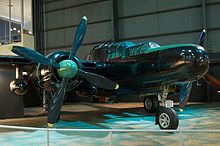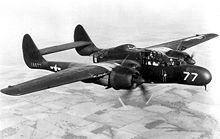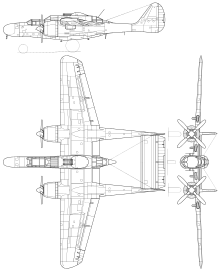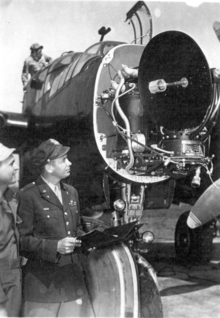Northrop P-61
| Northrop P-61 Black Widow | |
|---|---|
 USAAF's Northrop P-61A |
|
| Type: | Night fighter |
| Design country: | |
| Manufacturer: | |
| First flight: |
May 26, 1942 |
| Commissioning: |
1944 |
| Production time: |
1943 to 1946 |
| Number of pieces: |
742 |
The Northrop P-61 Black Widow (too dt . "Black Widow") was the first combat aircraft of the USAAF , the specially for the night fighter was developed. Due to the design with double tail booms, the P-61 was externally similar to the smaller Lockheed P-38 Lightning . It could carry up to four 726 kg bombs or four 12.7 cm HVAR (High Velocity Aircraft Rocket) missiles . Despite good flight characteristics and comparatively high numbers of kills, only 742 aircraft (including the version as a reconnaissance aircraft , the F-15 Reporter ) were produced, because at the end of the Second World War the propeller planes were to be gradually replaced by jet aircraft .
history
Even before the United States entered the war, the US Army Air Corps recognized the need for a night fighter in 1940 . The strength of the German night attacks on England in relation to the night defenses there had been observed with concern, and so on October 21, 1940 a tender was issued with the requirements for a night fighter.
On March 10, 1941, the Materiel Command placed an order with Northrop for two test samples (XP-61), only a short time later 13 prototypes (YP-61) were ordered and on September 1, 1941 an order for 150 series machines (P- 61A). These orders were placed before the XP-61's maiden flight in May 1942; apparently a lot was expected of this guy. The first 37 machines of the P-61A series (200 pieces) still had a turret on the back of the fuselage, but this led to severe instability in the area of the tail units and was omitted from the following machines.
The first 45 P-61A were powered by two Pratt & Whitney R-2800 -10 double radial engines . Thereafter, R-2800-65 engines were used, which differed only in a different ignition system from General Electric . Both engine variants (-10, -65) had a two-stage compressor and charge air cooling. Electrically adjustable four-blade propellers from Curtiss-Electric with a diameter of 3.70 m were used as propellers. A P-61A (USAAF Serial No. 42-5496) went to the Royal Air Force for testing , but was found unsuitable there. It was followed by the P-61B (number 450), which essentially had improvements in equipment and avionics . Among other things, a more powerful radar and two additional suspensions were installed under the wings. This doubled the possible external bomb load to 2,903 kg. The next version was the P-61C, which received other engines (R-2800-57, -73 or -77). These double radial engines only had a single-stage compressor with a fixed gear ratio. The charging for high altitudes was now done with the help of a GE -CH-5 turbocharger. This can be seen from the outside by the three additional air inlets on the lower front part of the engine cowling. The C-Model therefore achieved better flight performance (service ceiling: 12,497 m, top speed: 692 km / h) and was considered the most promising version, but was only used at the end of the war (July 1945). Therefore, the orders were reduced to 41 machines, 13 machines were even scrapped immediately after their completion. By then, the P-61 pilots had successfully shot down nine confirmed and a few more unconfirmed V1 cruise missiles.
After the end of the war, a few more attempts were made to find a suitable use for the P-61. Tests were continued with the two prototypes of the XP-61E, which had already been completed in March 1945. These were further enhanced long-range day fighters, designed as escort fighters for the B-29 Superfortress . A reconnaissance version with the designation XF-15 or XF-15A for a machine based on a P-61C was also created on the basis of this XP-61E. From 1930 to 1947, "F" stood for the use of "Photographic Reconnaissance" (photographic reconnaissance). In June 1945 the USAAF had already placed an order for 175 machines; The first flight took place on July 3, 1945 and in September 1946 the first F-15 Reporter was delivered. The F-15A was referred to as the RF-61C from 1948.
In cooperation with the US Weather Bureau (predecessor organization of today's National Oceanic and Atmospheric Administration ) various P-61 and F-15 were used for purposes of weather research as part of the “Thunderstorm” project from 1946 onwards. But the story of the reporter ended with the early cancellation of orders in 1947. By 1952 all P-61 and the 36 copies of the RF-61C had been retired; the planned long-range escort fighter was replaced by the North American F-82 Twin Mustang as early as 1948 .
production
Acceptance of the P-61 / F-15 by the USAF:
| version | 1943 | 1944 | 1945 | 1946 | 1947 | TOTAL |
|---|---|---|---|---|---|---|
| XP-61 | 2 | 2 | ||||
| YP-61 | 13 | 13 | ||||
| P-61A | 19th | 181 | 200 | |||
| P-61B | 268 | 182 | 450 | |||
| P-61C | 37 | 4th | 41 | |||
| F-15 | 19th | 17th | 36 | |||
| TOTAL | 34 | 449 | 219 | 23 | 17th | 742 |
Whereabouts

Only four P-61s remain, two are shown in US collections, one in a Chinese one and one is being restored to airworthiness.
- The aircraft shown in China at the Beijing Aeronautical Institute was one of three deputy P-61A of the 427th Night Fighter Squadron (427th NFS) captured by communist troops at the end of the war. The aircraft is marked 7602 and 25171 , but its exact identity is unknown. There may be other machines of the same type in China.
- The machine, which is to be restored to an airworthy condition at the Mid-Atlantic Air Museum in Pennsylvania , was recovered in the western part of New Guinea , where it crashed on the slopes of Mount Cyclops near Hollandia in 1945 and returned in 1991 had been moved to the United States. It is a P-61B with USAAF serial number 42-39445 that was in service with the 550th NFS.
- The USAF Museum displays a P-61C that was given to the Boy Scouts of Urbania, Ohio in 1954 , then sold to collector Earl Reinert in 1958. He passed the machine on to the museum in the same year. It bears the markings of the 550th NFS Moonlight Serenade .
- Another machine (43-8330) is owned by the Smithsonian Institute ; it is parked at Andrews Air Force Base , Maryland .
Military users
Technical data P-61B
| Parameter | Data |
|---|---|
| crew | 3 |
| length | 15.09 m |
| span | 20.11 m |
| height | 4.47 m |
| Empty mass | 9,979 kg |
| Takeoff mass | 13,472 kg |
| Max. Takeoff mass | 17,237 kg |
| Landing speed | 151 km / h |
| Cruising speed | 322 km / h |
| Top speed | 589 km / h |
| Climb performance | 6,096 m in 12 min |
| Service ceiling | 10,640 m |
| Fuel capacity | 2,385 l (internal) |
| Range | 1,625 km (4,820 km with external tanks) |
| Engines | two 18-cylinder radial engines Pratt & Whitney R-2800-65 Double Wasp with 1,491 kW (2,028 hp) each at 2,700 rpm |
| Armament | four 20-mm automatic cannon forward, four 12.7 mm MG Browning M2 in revolving tower on top of the fuselage and up to 2,904 kg bomb load |
literature
- Gerhard Siem: Military machines of the world. 1st edition, GeraMond Verlag, Munich 2001, ISBN 3-932785-85-1 .
- Aero 73: Northrop Black Widow - Black as the night. Marshall Cavendish International Ltd., 1984, pp. 2029-2034.
Web links
Individual evidence
- ↑ Statistical Digest of the USAF 1946, p. 100 ff .; 1947, p. 115; www.uswarplanes.net
- ^ Page of the Mid-Atlantic Air Museum on the restoration of the P-62
- ↑ The Last Widows. In: Wings of Fame. Vol. 15, 1999, p. 93
- ^ Graham White: R-2800 Pratt & Whitneys Dependable Masterpiece . ISBN 0-7680-0272-9 .


